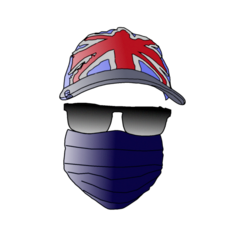-
Posts
11 -
Joined
-
Last visited
Awards
This user doesn't have any awards
Profile Information
-
Gender
Male
System
-
CPU
4690k
-
Motherboard
GA-B85M-DS3H
-
RAM
16GB
-
GPU
AMD R9 380
-
Case
Antec Three Hundred
-
Storage
6TB SATA + 120GB SSD
-
PSU
Antec 650
-
Display(s)
54" Plasma TV
-
Cooling
Coolmaster Hyper T2
-
Sound
AMD HDMI audio
-
Operating System
Windows 10 x64
Recent Profile Visitors
594 profile views
Lardzor's Achievements
-
I'd love to win this great little projector. I didn't see a security slot like laptops have to lock it down. I wouldn't want anyone to just stick it under their shirt and walk off.
-
If it's not too late, take the ferry across S.F. bay. It's cheap.
-
My CPU fan. My old PWM CPU fan failed a while back so I got a new fancy high speed fan off of Amazon. It goes over 7000 rpm, but it never really goes above 2500 because even if I'm encoding video, my CPU never gets that hot. I've got a 4690K CPU so I can overclock it, but I only have it at 4.4 Ghz because my motherboard isn't great for overclocking. I can force the fan up over 7000 RPM with the utility SpeedFan, but when I do, it sounds like a freaking jet engine, so maybe it's a good thing.
-
Could you please make a comprehensive tutorial on how to create a remote VPN connection to a home Local Area Network using the built in VPN that comes with Windows. Please include the benefits of having a secure encrypted connection to your person LAN, and how to overcome typical obstacles like your router/ISP firewall(s). Plus a demonstration showing how well it works for you. I would like to see the VPN extension of home networks become a more mainstream practice. Regards, Lardzor
-
Lardzor changed their profile photo
-

Linus: Reflowing is WRONG, from Louis Rossmann
Lardzor replied to LinusShillTips's topic in Off Topic
I'm curious. Louis mentions Bumps bonding the silicon die to the substrate ie: the 'wafer-bumping'. method of die bonding. He says the problem is that the bumps get messed up over time due to repeated heating and cooling and they are completely encased in underfill so they can't be accessed to repair. https://www.youtube.com/watch?v=1AcEt073Uds#t=5m32s and https://www.youtube.com/watch?v=E9aZZxNptp0#t=3m13s He seems to imply the solder balls and the bumps are not related, but the bumps in wafer-bumping are composed of solder also. https://www.youtube.com/watch?v=vKj3eXgyC5c#t=20m50s The silicon die is basically bonded to the substrate the same way the substrate is bonded to the graphics card's circuit board. The main difference being that the silicon die also uses an epoxy underfill between the die and substrate (epoxy/fiberglass composite) for solder joint protection and added bonding strength. So if the bumps are solder based, why can't the solder bumps be reflowed? Louis also says that lead free solder melting point is never reached, I don't know what type of solder AMD uses in their chips, but Nvidia apparently does use high lead based solder in their chips, and this is the root of their problem. "According to our sources, the failures are caused by a solder bump that connects the I/O termination of the silicon chip to the pad on the substrate. In Nvidia’s GPUs, this solder bump is created using high-lead." and "What supports the theory that a high-lead solder bump in fact is at fault is the fact that Nvidia ordered an immediate switch to use eutectic solders instead of high-lead versions in the last week of July." http://www.tgdaily.com/hardware-features/39045-nvidia-gpu-failures-caused-by-material-problem-sources-claim Commonly used lead solders do melt at below 385F according to Wikipedia: (I also heard the term eutectic used so I'll include that here also) "Alloys commonly used for electrical soldering are 60/40 Tin/lead (Sn/Pb) which melts at 188 °C (370 °F)[9] and 63/37 Sn/Pb used principally in electrical/electronic work. The 63/37 is a eutectic alloy, which has the lowest melting point (183 °C or 361 °F) of all the tin/lead alloys; and the melting point is truly a point — not a range." https://en.wikipedia.org/wiki/Solder#Lead_solder I guess what I really want to know is how the bumps get "destroyed, sodomized, beat-to-shit" so baking them to a reflow temperature is not a valid option for repair? -

In regard to Louis Rossman's video on baking graphics chips.
Lardzor replied to Lardzor's topic in Graphics Cards
In the sense that resoldering a fractured solder joint is just a temporary fix. The root cause of the solder joint fatigue (thermal expansion stress) would still remain. -
Recently Linus Tech Tips released a video about Fixing graphics cards by baking them in an oven to reflow the solder on solder joints that have cracked due to thermal expansion. Louis Rossman has a channel where he argues that this is a bad idea and seems to imply that baking a circuit board in an oven is stupid. https://www.youtube.com/watch?v=E9aZZxNptp0#t=2m25s Most modern graphics card circuit boards and flip-chip CPU/GPUs have already been baked in a reflow oven during the manufacturing process. Only some of the components that are NOT surface mount components like power plugs and basically anything that pokes all the way through the circuit board and pokes out the other side are wave soldered on in a second stage. Those components may not be designed for high temperatures, where the surface mount components are. So baking a circuit board in an oven is not a new experience for a graphics card. I did a little research on flip chip bonding and I found a very informative video about flip chip bonding with the little bumps that bond the chip to the substrate that Louis Rossmann refers to in his video at 2:25 https://www.youtube.com/watch?v=vKj3eXgyC5c#t=19m40s Yes, their are bumps that bond the chip to the substrate, and yes, the bumps are completely encased in underfill and you can not get to them, but what Louis seems unaware of is that the bumps are actually mad of solder (solder bumps) and that means they can be reflowed. It briefly mentions at 29:30 how there can be solder joint fatigue in the solder bumps due to differences in thermal expansion coefficients between the chip and the substrate and the importance of using underfill. My link skips ahead to flip chip bonding. The first part of the video deals with wire bonding with non-flip chips and not relevant to this topic. TL:DR Don't sweat it Linus, you got the science on your side. Regards, Lardzor
-
I'd love to receive an Excalibur v2 keyboard because I tried to fix my old Model M and realized after the fact that I didn't have the tools to do it properly. My backup keyboards a cheap and squishy and the Tesoro Excalibur v2 looks awesome.
- 6,651 replies
-
- tesoro
- excalibur v2
-
(and 1 more)
Tagged with:
-
Looks like you just need a piece of glass and a spray on coating. Something better than Pam cooking spray though.
-
I've looked into DIY rear projection screens online, and the biggest problem seems to be finding a suitable material for the screen, and mounting it so that the screen is taught and there are no wrinkles. DIY successes seem to always involve shower curtain material for the screen. I suppose it's because shower curtains are a transparent material that also diffuses light. You don't want to use a material with white pigment that reflects light, you want a clear material that is textured or frosted to diffuse light. It seems some shower curtains fit that bill. I was thinking for a small desk-sized screen, a thin clear sheet of plastic would work if it could diffuse the light. Maybe use sand paper on it, or spray on come cooking oil like Pam cooking spray.
-
We've all seen 3 monitor gaming set ups on someones desk, but the flat screens make the 3 monitors look like half of a hexagon, and the bezels are a big distraction. What if you could have all that resolution on a perfectly curved 180 degree screen with no bezels. I think it's possible using projectors and edge-blending. I just thought it would be cool if Linus Tech Tips could build a desk with a built-in ultra wide, rear projection display that curved 180 degrees. I was thinking about a crescent shaped desk with a curved rear projection screen mounted on it, using 3 edge-blended pico projectors. You should be able to get over 180 degree field of view even with overlap for edge blending, and some pico projects like those from Microvision use a lens-less technology that gives them 'Infinite-focus' so they can project onto a curved surface without any blurring. Basically like a smaller version of the display in this video, except with 3 rear mounted projectors instead of 2 forward mounted ones. Microvision Infinite Focus: Edge Blending:
-
I would be happy with either mouse, but I would prefer the Roccat Kova. It's higher resolution and 12 buttons appeal to me as a gamer. I've been looking for a replacement for my trusty Logitech MX510 eight button gaming mouse. I've replaced the USB cable twice, and a couple of its micro-switches as well. I fear it's lifespan will soon come to an end. Regards, Lardzor






